When I was a kid, I was a New York Yankees baseball fan. Why? I’d never been to New York; I lived in the midwest. I loved the baseball team because they won a lot. The saying way back then was, “The American League battle isn’t to determine who wins, but which team might come in second.” Everybody knew the Yankees would win again. (As I said, this was some time back in history.)
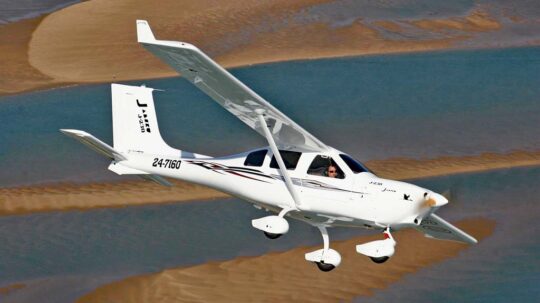 In light aviation, we have a roughly similar situation. Rotax provides somewhere around 70-80% of all engines for aircraft in the light aircraft space globally. The remaining 20-30% is divided between Continental or Titan, Jabiru, ULPower, and a growing collection of converted auto engines (though the latter, without ASTM approval, are used only on kit aircraft or ELSAs).
In light aviation, we have a roughly similar situation. Rotax provides somewhere around 70-80% of all engines for aircraft in the light aircraft space globally. The remaining 20-30% is divided between Continental or Titan, Jabiru, ULPower, and a growing collection of converted auto engines (though the latter, without ASTM approval, are used only on kit aircraft or ELSAs).
US Sport Planes owner Scott Severen, who represents Jabiru in America, declared for the Australian manufacturer, “The 4,000th Jabiru 2200 four-cylinder, 81-horsepower engine [was] recently produced at the Jabiru facility.” And, he added, “The 3300 engine [series is] fast approaching this number, too.”
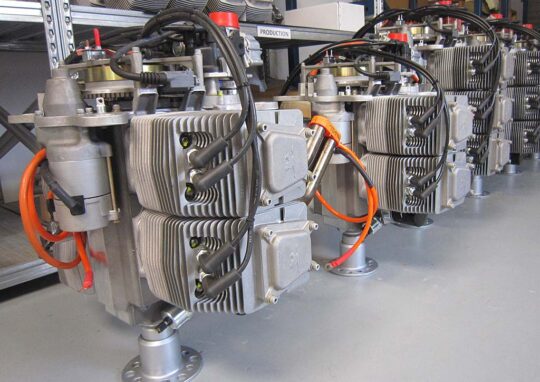
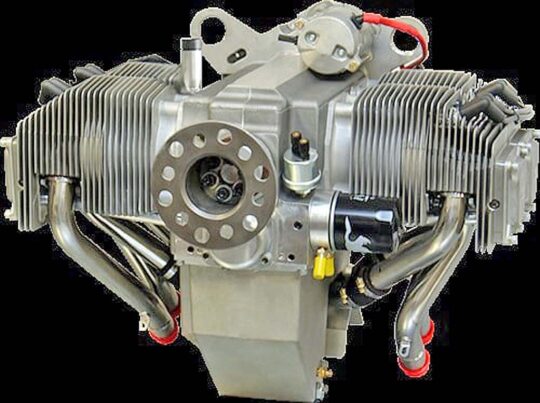
Jabiru has shipped number 4,000 of this 2200 engine model.
Regarding the more potent six cylinder model, Jabiru stated earlier, “Our 3,000th Jabiru 3300 engine has come through production and [is] ready for delivery. Now marketed as a Gen 4 Jabiru 3300 engine, this engine is the result of continual evolution since the first production engine in June of 1998. Easily delivering 120 horsepower with a weight of just 83.5 kilograms (184 pounds), this engine has made the Jabiru J230 our most popular model of aircraft.” The Jabiru 3300 engine has proved popular in many other types of airframes as well.
While the four cylinder model passes a major benchmark, the company recalled, “The 2200 engine started production a few years earlier than the 3300 engine so it will be awhile before the 3300s catch up to the numbers of 2200 engines but they are gaining on them.”
Congratulations, Jabiru!
JABIRU ARTICLE LINKS:
- US Sportplanes, American representative for Jabiru Aircraft
- Arion Aircraft, American sales and service for Jabiru Engines
- Jabiru factory website
TOTAL ENGINE MARKET
While I congratulate Jabiru on their achievement in building engines, I took extra time to research the state of all engines in the Light-Sport Aircraft field — and this won’t even count developments like turbine, though it is beginning to show the presence of some electric-powered aircraft.
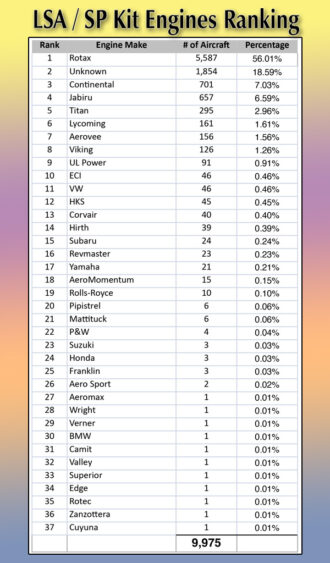
Data source: FAA registration database, professionally assembled by Steve Beste.
The information in the table was created from work by our datastician extraordinaire, Steve Beste (article), who often adds some observations I find valuable. See this page about Steve and others who help this website.
So, Rotax dominates. Well, you knew that, right? In fact, Rotax’s presence around the world, outside the United States, is even stronger, probably closer to 70-80%. The big Austrian engine manufacturer works with more than 200 OEMs (original equipment manufacturers, meaning airframe builders) in nearly every country on Earth.
Many countries do not allow homebuilt aircraft and that’s unfortunate because such aircraft provide fertile ground for a new engine producer to get started. Perhaps this explains why the USA has so many different engines in our list.
For those of you who want to plow down to every single engine on every single Light-Sport Aircraft or Sport Pilot-eligible kit-built aircraft, check this long PDF file to see every entry in our comprehensive database. Learn more beyond engines from our Tableau Public market info page.
If you are puzzled, as I was, by the #2-ranked Unknown listing, here is Steve’s response: “The ‘Unknown’ refers to aircraft where the FAA data is blank in respect to the engine. Presumably, these aircraft have engines, but the FAA doesn’t know what kind. This is a data-quality problem common to all databases. No database of any size ever has perfectly clean and complete data, contrary to what people assume.”
“I was surprised to find ‘Pipistrel’ engines,” Steve also wrote. Pipistrel makes airframes and then installs Rotax or other engines into them, don’t they? Well, yes, that’s been most of their history. Yet in recent years Pipistrel has engaged deeply in electric-powered aircraft and this data has begun to creep into our comprehensive review. (Choosing to pursue electric power appears to have been a shrewd move as Textron paid a boatload of money [more than $200 million, it has been reported!] to acquire the Slovenian company, allegedly mainly for its pioneering work in electric propulsion.)
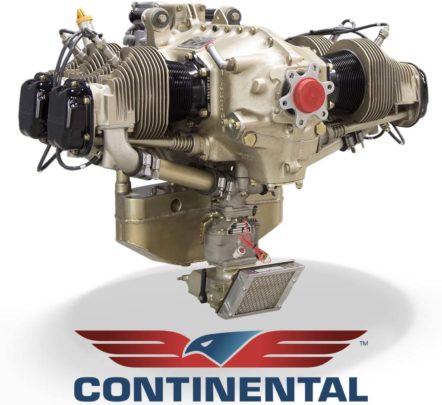
Then Steve noted, “I was shocked to see that we have ten ‘Rolls-Royce’ engines! I thought it was bad data. Turns out, it’s a bunch of CarbonCubs that use a Rolls-Royce-licensed version of the Continental O-200.
Steve continued writing, “One website reported: ‘In a cooperative venture, Rolls-Royce produced these same designs in England, under separate certification, with model designations beginning RR, e.g., the Rolls-Royce RR C90-12FH is the equivalent of the Continental C90-12FH.'”
The Rolls-Royce versions were said to be “directly interchangeable with the equivalent models manufactured by Continental.”
Dig further if you wish. It’s all here to read as this article uncovers the breadth of the light aircraft powerplant market.
ENGINES ARTICLE LINKS:
- Tablean Public marketing info page — covers Light-Sport Aircraft and Sport Pilot-eligible kit-built aircraft
- Every engine counted for this article, long PDF document
- Rotax Aircraft Engines, info on this website with link to Rotax’s factory website


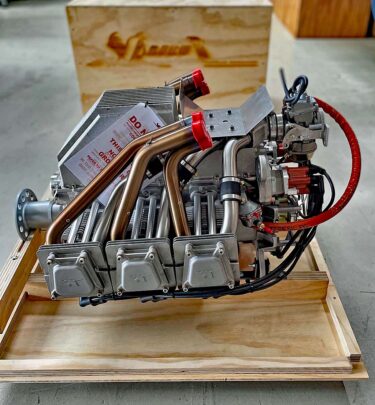
I would think that a Harley Davidson engine or one of its clones would make the perfect 80 to 120 hp engine.
The current Gen 4 Jabiru variant comes with a number of technological changes..
All engine manufacturers are faced with Covid and Ukranian supply chain challenges.
Nice having so many options, hope all the new low count manufacturers can survive.